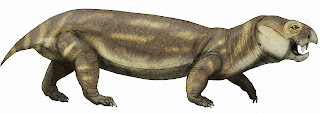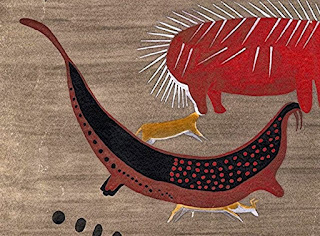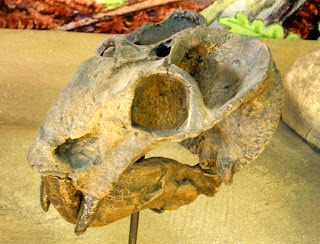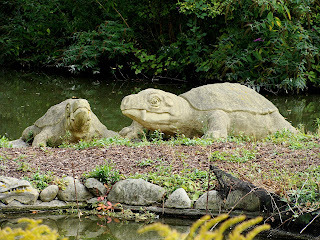A DICYNODONT DEPICTION?
 Life restoration of Dicynodon lacerticeps, a dicynodont from the Late Permian, SouthAfrica (© ДиБгд-Wikipedia –
CC BY 4.0 licence
)
Life restoration of Dicynodon lacerticeps, a dicynodont from the Late Permian, SouthAfrica (© ДиБгд-Wikipedia –
CC BY 4.0 licence
)A farm named La Belle France, situatedat Brackfontein Ridge in the Karoo region of South Africa's Free StateProvince, has long been known for the exquisite cave paintings on the wall of acave in its grounds – and especially for one particular painting dubbed theHorned Serpent, which bears no resemblance to any known animal alive today. Itscurved, elongate, spotted body has four paddle-like limbs and a small head butbearing a pair of very large downward-curving tusks, giving it a resemblance tothe head of a walrus. But there have never been walruses in this area, ever. Sounless it is simply wholly imaginary, a spirit beast, what could this depictedcreature represent?
Cryptozoologists have speculatedwhether it may have been some form of aquatic sabre-tooth tiger, an idea datingback at least as far as Bernard Heuvelmans's writings in his 1978 book Les Derniers Dragons d'Afrique, and whichI have already documented in detail here on ShukerNature.
 The 'Horned Serpent' petroglyph (public domain)
The 'Horned Serpent' petroglyph (public domain)
However, a wholly new and very convincingidentity has now been proposed, in a thought-provoking PLoS ONE paper authored by Dr Julien Benoit, from the EvolutionaryStudies Institute and School of Geosciences, at the University of theWitwatersrand, in Johannesburg (click here to access it, and here to access a popular-format articleregarding it in The Conversation). The cave paintings were produced by the Sanpeople, formerly known as the Bushmen of the East, indigenous hunter-gathererswho no longer inhabit this particular region, but were well aware of thewildlife around them and were accomplished artists, portraying such creaturesin their cave paintings. The San left this area in 1835, which therefore meansthat this is the latest date by which the Horned Serpent painting could havebeen produced by them. However, it may have been made much earlier, because theSan had lived here for thousands of years, and in this very same area are countlessfossils that may well provide the answer to the mystery of the Horned Serpent'szoological identity, as Benoit has proposed.
The fossils are mostly of ancientreptiles known as dicynodonts, which became extinct here around 250 millionyears ago, during the Upper Permian Period. The principal species is Dicynodonlacerticeps, averaging 4 ft in total length, whose squat body and fourfairly stout limbs render it relatively undistinguished in appearance – except,that is, for its single pair of very sizeable, downward-curving, tusk-liketeeth. Benoit had previously discovered that the San people inhabiting Lesotho,which neighbours South Africa's Free State, had incorporated depictions offossil dinosaur footprints into their cave paintings there, so he has nowproposed that the South African Karoo's Horned Serpent was their attempt toreconstruct, like veritable proto-palaeontologists, the appearance in life ofthe long-extinct dicynodonts, because its tusked head does bear a distinctresemblance to fossil dicynodont skulls and teeth present in this same area.
 A fossil Dicynodonskull (© Ghedoghedo/Wikipedia –
CC BY-SA 3.0 licence
)
A fossil Dicynodonskull (© Ghedoghedo/Wikipedia –
CC BY-SA 3.0 licence
)
Put another way, it is certainly a most notable coincidence thata mysterious tusked beast should be depicted by indigenous artists in the sameregion where fossil skulls and teeth of a distinctively tusked species are commonlyfound. But that is not all. To quote Benoit:
The body of the tusked animalfrom La Belle France [Horned Serpent], as painted by the San, is strangelyflexed like a banana, a pose that is commonly encountered on fossil skeletonsand is called the "death pose" by palaeontologists. Its body is also coveredwith spots, not unlike the mummifieddicynodonts found in the area whose skin iscovered with bumps.
Personally, therefore, I think it likely that the longstandingmystery concerning what the Horned Serpent cave painting represents, and whoseexistence was first brought to widespread attention almost a century ago, in1930, is now finally solved.
 Two of the nowadayspalaeontologically-inaccurate but still historically-significant life-sized dicynodontsculptures created during the early 1850s by English sculptor Benjamin WaterhouseHawkins for display at southeast London's Crystal Palace Park and which, along withmany other sculptures of prehistoric fauna prepared by him, can still be seen todayat Dinosaur Court in Crystal Palace Park; NB - an extensive documentation of their history and also that of the cryptozoological jungle walrus linked to the Horned Serpent petroglyph can be found in my book
ShukerNature Book 3: Crystal Palace Dinosaurs, Jungle Walruses, and Other Belated BlogBeasts
(© Ben Sutherland/Wikipedia –
CC BY 2.0 licence
)
Two of the nowadayspalaeontologically-inaccurate but still historically-significant life-sized dicynodontsculptures created during the early 1850s by English sculptor Benjamin WaterhouseHawkins for display at southeast London's Crystal Palace Park and which, along withmany other sculptures of prehistoric fauna prepared by him, can still be seen todayat Dinosaur Court in Crystal Palace Park; NB - an extensive documentation of their history and also that of the cryptozoological jungle walrus linked to the Horned Serpent petroglyph can be found in my book
ShukerNature Book 3: Crystal Palace Dinosaurs, Jungle Walruses, and Other Belated BlogBeasts
(© Ben Sutherland/Wikipedia –
CC BY 2.0 licence
)
Karl Shuker's Blog
- Karl Shuker's profile
- 45 followers



